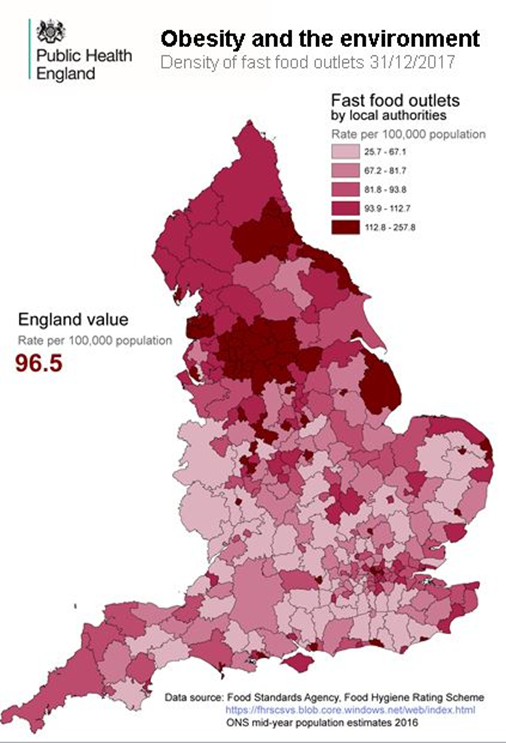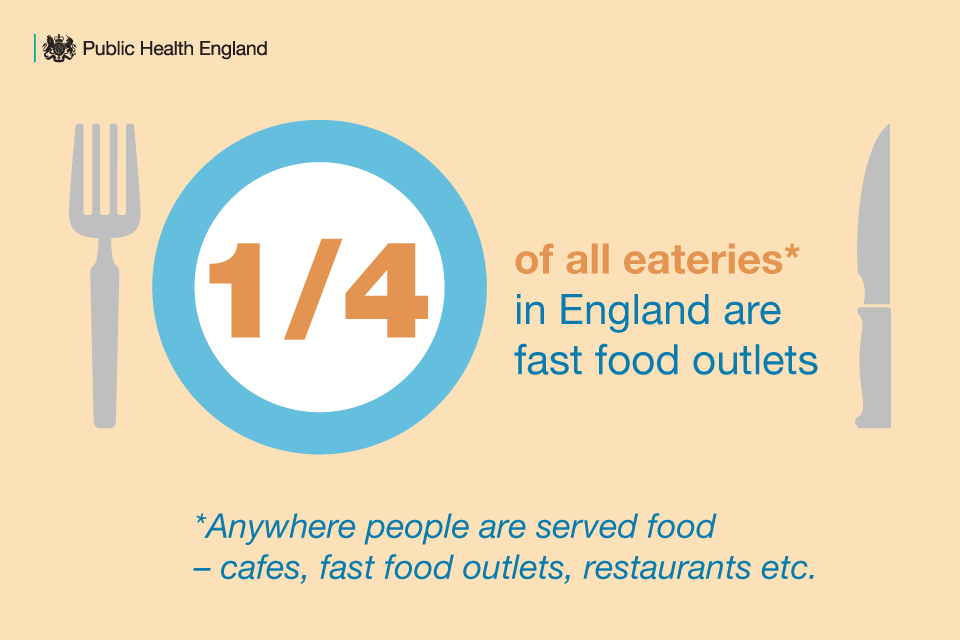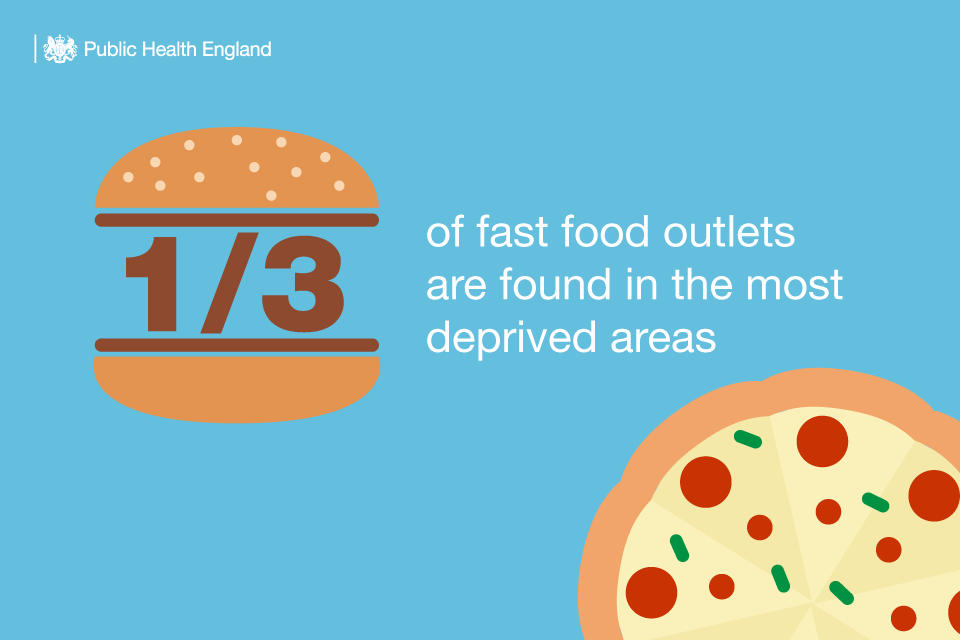Putting healthier food environments at the heart of planning

Our local surroundings have a large impact on us and we live in an environment that can inadvertently encourage unhealthy behaviours – eating more and exercising less. Factors affecting our choices can include access to active travel and availability of green spaces, as well as the density of fast food outlets.
Many of our streets are saturated with fast food outlets, selling food such as chips, burgers, kebabs, fried chicken and pizza. The sheer density of these outlets may make it easier for us to consume too much, too often – and the fact that most outlets have no or limited nutrition information in store can make informed choices difficult.
Excess calories are the root cause of the obesity problem
While not all fast food is unhealthy, it is typically high in saturated fat, salt and calories. Excess calorie consumption is the root cause of the obesity crisis, with overweight or obese children consuming up to 500 extra calories per day, depending on their age and sex.
Children with excess weight are more likely to be overweight or obese as adults, increasing their risk of preventable diseases such as type 2 diabetes, heart disease and some cancers.
With a third of children leaving primary school overweight or obese, shaping our food environment is important to supporting healthier lifestyles.
Where are England’s fast food hotspots?
Analysis from PHE shows the density of fast food outlets varies per local authority, ranging from 26 to 232 outlets per 100,000 population, with the average across England being 96.5. It provides evidence highlighting the availability of fast food outlets in some of the country’s most disadvantaged areas.
The map below illustrates the number of fast food outlets per 100,000 population by local authority, and the variation across England.

Restricting fast food outlets
Both the built and natural environments can have an influence on our health and wellbeing. Children may find it more difficult to make healthier choices when exposed to so many fast food options, whether on their way to and from school or out with friends.
Local authorities have powers to help shape these environments, including tackling the growth of new fast food outlets, but also introducing more cycling paths, and making the best use of open green spaces.
Some local authorities have shown great leadership in this area, and the updated childhood obesity plan includes a three-year trailblazer programme to identify what works and share best practice. This will include resources to further support local authorities in using their existing powers, with the aim to increase the proportion of local authorities addressing childhood obesity over the next five years. We’ve seen bold, forward-thinking action in some areas and we look forward to seeing how other local authorities can learn from each other.

PHE has worked with the Ministry of Housing, Communities and Local Government to strengthen planning policy to create healthier environments. The new section of the Health and Well-Being Planning Practice Guidance (PPG) will affect all future planning decisions in England, with local authorities now obliged to take it into account when preparing local plans or deciding on planning applications.
As part of the PPG, authorities are encouraged to use their planning decisions to restrict fast food outlets, including:
- locations where children and young people congregate such as schools, community centres and playgrounds
- areas with high levels of obesity, deprivation and general poor health
- areas with over-concentration and clustering of outlets within a specified area
We have also produced a toolkit to help local authorities work with local businesses to provide healthier alternatives to their biggest sellers – for example by using less salt, sugar, calories, saturated fat and offering smaller portions. This will help consumers enjoy healthier versions of the meals they already consume – and they may not even notice the difference
Taster’s Fried Chicken Shop in Tottenham shows that with the right leadership and collaboration, this can be achieved – it is a small business working with the local authority to help families and children choose healthier options. As well as introducing a healthier menu, employees are trained to signpost customers to healthier choices, with promising results.
The Government is committed to tackling obesity
Government is committed to tackling childhood obesity on a national level and PHE plays a significant role in the challenge.
The latest chapter of the government’s childhood obesity plan includes a consultation on mandatory calorie labelling in the out of home sector. If successful, this would level the playing field and offer more transparent choice for consumers, as calorie information is already mandatory for pre-packaged foods and drinks in the retail sector. With fast food outlets seemingly on every corner, they may still prove difficult to resist for many – but clear and consistent calorie labelling at the point of choice is a significant step forward for making an informed choice when eating out and about.
We know many parents find it difficult to make healthier choices for the family when eating out, so this may make it easier for them.
The government’s calorie and sugar reduction programmes have challenged the food industry to reduce sugar and calories in their most popular products – 20% of sugar by 2020, and 20% of calories by 2024. These, together with the government’s Soft Drinks Industry Levy, cover 50% of children’s total calorie intake.
These national efforts are helping to make many everyday foods and drinks healthier by targeting the big players. However sustained local action is also needed to help smaller businesses play their part.

What does success look like?
Many local authorities are taking positive action to change the food environment – we believe at least 40 local authorities have introduced Supplementary Planning Documents (SPD) to restrict the growth of new takeaways and fast food outlets.
The Gateshead and Newcastle Core Strategy and Urban Core Plan (2015) set out an intention to improve access to healthier food and control the location of, and access to, unhealthy food outlets.
Gateshead Council has developed a hot food takeaway SPD. The SPD, supported by an integrated public health policy, was used to successfully control the proliferation of takeaways in areas with high levels of childhood obesity.
In addition to other criteria, planning permission for a hot food takeaway is not given where:
- children and young people congregate
- high levels of obesity are observed
- there is an over proliferation of hot food takeaways
- clustering of hot food takeaways will have a negative impact on the vitality of the local area.
Since the SPD was adopted, all hot food takeaway applications must be accompanied by a health impact assessment. Since adopting this approach, no new planning applications for hot food takeaways have been approved under the new SPD.
Following this work, the council has set the following targets:
- to reduce the number of obese children in Year 6 (aged 4-5 years) in Gateshead to 10% by 2025
- to reduce the number of adults with excess weight to below 40% by 2030.
Gateshead is just a single example of a local authority taking positive action to change the food environment – many others are also doing impressive work to tackle obesity.
Local authorities clearly have a challenge on their hands in balancing healthier environments with the demand for thriving and vibrant high streets.
However, with the impact of obesity on local authority social care budgets estimated at £352 million per year, encouraging healthier choices can make a positive difference.
from Public health matters https://ift.tt/2tF1PYV




No comments